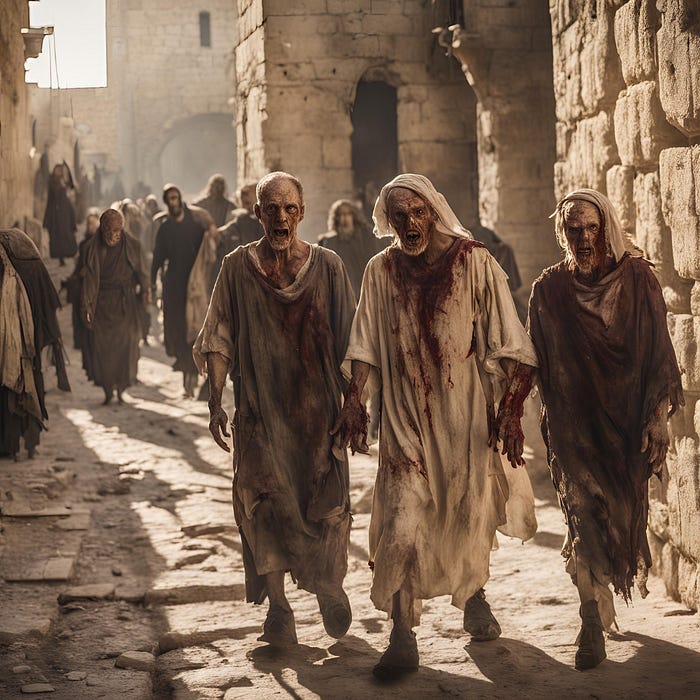How Can We Explain the Zombies in Matthew 27:51–53?
Taking a deep dive into one of the strangest passages in Scripture
Why does the Bible talk about zombies?
To be clear, Matthew doesn’t use the word “zombies.” Yet he describes a host of dead bodies rising from their graves and walking around Jerusalem. A touch of imagination quickly connects such a description to our modern zombie craze.
Let’s dig into this bizarre little passage and see why Matthew included it in a Gospel he expected everyone to take seriously.
Let’s read exactly what Matthew records, beginning with the earthquake:
At that moment [when Jesus died on the Cross] the veil of the Temple was torn in two from top to bottom. The earth quaked and the rocks were split. The tombs broke open (Matthew 27:51)
Multiple ancient sources record the earthquake of April 3, 33 AD/CE. If you want to view the evidence of the earthquake with your own eyes, you can.
Such an earthquake would certainly break open the seals on many tombs, as tombs were carved into walls of rock and sealed with an upright stone rolled over the doorway. The earthquake could easily dislodge many of those door-stones, leaving them to crack, fall over, or simply roll away.
So far, Matthew’s account makes a fair amount of sense.
Now let’s take the rest of it:
At that moment [when Jesus died on the Cross] the veil of the Temple was torn in two from top to bottom. The earth quaked and the rocks were split. The tombs broke open, and the bodies of many saints who had fallen asleep were raised. After Jesus’ resurrection, when they had come out of the tombs, they entered the holy city and appeared to many people (Matthew 27:51–53)
According to Matthew, many of these newly-opened tombs contained the bodies of dead saints. Matthew claims that when Jesus rose, they rose, and appeared to many in the city.
Is such a thing even possible? Could dead people walk around a city? If it happened, would it really skip the notice of any other ancient historian?
Actually — yes.
If Matthew’s zombie event happened exactly as he describes, we should expect to find precisely what we have: a description in the Bible but complete silence from any other historical source.
A little knowledge of Israelite burial customs explains why.
Once a person died in Israel, they were buried near immediately. The Jewish people did nothing to preserve the bodies. They wrapped them, put spices on them, then locked the body away in the family tomb. After a year, everything had rotted but the bones. At that point, the men of the family would place the bones in a bone box for a more permanent burial.
With that background, consider Matthew’s claim that the dead bodies of saints revived.
For a body to be revived, it had to still exist. Thus these were recent burials — no longer than a year prior, or the bodies would have rotted away to nothing.
Therefore, we’re not dealing with ancient saints from centuries past.
We’re dealing with people who had recently been buried, as recently as a few days or weeks. They revived and returned into the city.
That would still be notable, enough so for Matthew to record.
But it is not a zombie scenario, with rotting corpses stumbling about, which everyone would notice. Nor is it as shocking as ancient saints from deep history reviving.
It’s a much more mundane and personal form of excitement. The families of these saints would be ecstatic to receive them back. Immediate families would cherish seeing those they had recently buried.
But Roman officials wouldn’t see anything out of the ordinary.
Someone might come up to them and say “Here’s my dad! We buried him last week but he’s alive again!”
The Roman official would probably think the person was a bit loopy. After all, here’s their dad, looking perfectly normal. There would be little for the Romans to note or care about. Even if they took the Roman official to the tomb, the official would have no way of proving that their dad had indeed been buried there. To the Roman official, it would simply look like every other tomb.
Because the Roman officials had little concern for Jewish saints, they had precious few ways to verify that these dead saints had indeed revived.
But the immediate families, those who knew and loved these saints, would receive them with great joy.
Thus it makes perfect sense why Matthew would record this, but no Roman record exists.
To Matthew, and his audience of faithful Jewish Jesus followers, this was a cherished event. Many of these saints and their families would be in Matthew’s audience. The mention of this moment would delight them and encourage their faith, again pointing them to the Jesus whose death and Resurrection made it possible.
But the Romans would have no reason to record it, because everything would look normal to them. Only those who knew the saints personally would rejoice at the memory of this moment.





